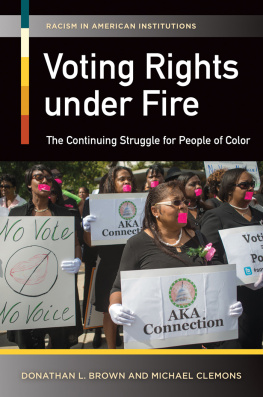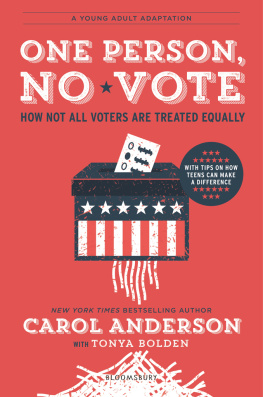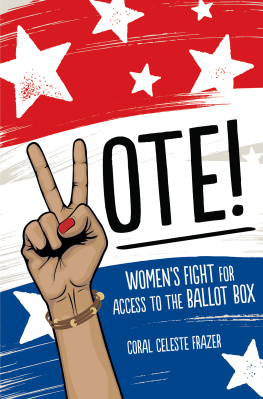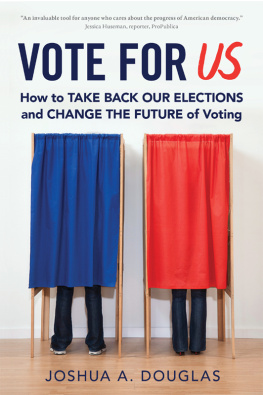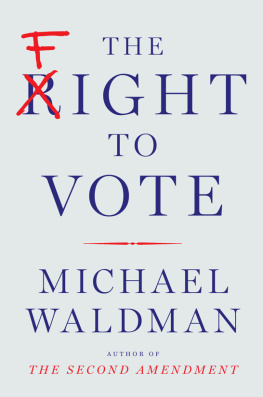Thank you for downloading this Simon & Schuster eBook.
Join our mailing list and get updates on new releases, deals, bonus content and other great books from Simon & Schuster.
C LICK H ERE T O S IGN U P
or visit us online to sign up at
eBookNews.SimonandSchuster.com
We hope you enjoyed reading this Simon & Schuster eBook.
Join our mailing list and get updates on new releases, deals, bonus content and other great books from Simon & Schuster.
C LICK H ERE T O S IGN U P
or visit us online to sign up at
eBookNews.SimonandSchuster.com
A LSO BY M ICHAEL W ALDMAN
The Second Amendment: A Biography
My Fellow Americans: The Most Important Speeches of Americas Presidents from George Washington to Barack Obama
A Return to Common Sense
POTUS Speaks
Who Robbed America? A Citizens Guide to the S&L Scandal
Who Runs Congress
(with Mark Green)

Simon & Schuster
1230 Avenue of the Americas
New York, NY 10020
www.SimonandSchuster.com
Copyright 2016 by Michael Waldman
All rights reserved, including the right to reproduce this book or portions thereof in any form whatsoever. For information, address Simon & Schuster Subsidiary Rights Department, 1230 Avenue of the Americas, New York, NY 10020.
First Simon & Schuster hardcover edition February 2016
SIMON & SCHUSTER and colophon are registered trademarks of Simon & Schuster, Inc.
For information about special discounts for bulk purchases, please contact Simon & Schuster Special Sales at 1-866-506-1949 or .
The Simon & Schuster Speakers Bureau can bring authors to your live event. For more information or to book an event, contact the Simon & Schuster Speakers Bureau at 1-866-248-3049 or visit our website at www.simonspeakers.com.
Book design by Ellen R. Sasahara
Jacket design by Tom McKeveny
Library of Congress Cataloging-in-Publication Data
Names: Waldman, Michael, 1960 author.
Title: The fight to vote / Michael Waldman.
Description: New York : Simon & Schuster, 2016. | Includes bibliographical references and index.
Identifiers: LCCN 2015030899
Subjects: LCSH: SuffrageUnited StatesHistory.
Classification: LCC JK1846.W352016|DDC 324.6/20973dc23
LC record available at http://lccn.loc.gov/2015030899
ISBN 978-1-5011-1648-3
ISBN 978-1-5011-1650-6 (ebook)
To Liz
CONTENTS
INTRODUCTION
O N A UGUST 9, 1787, in a locked room at the Constitutional Convention, delegates debated the shape of Americas new system of elections. A handful wanted to give state legislatures unfettered power to set the rules. But James Madison recoiled. The Virginian, architect of so much of the Constitution, was determined to give the national government authority to override the machinations of state politicians.
It was impossible to foresee all the abuses that might be made of the discretionary power, Madison warned. He sketched out an array of ways to manipulate voting rules: Whenever the State Legislatures had a favorite measure to carry, they would take care so to mould their regulations as to favor the candidates they wished to succeed. Madisons view carried the day.
Well over two centuries later, on June 25, 2013, the U.S. Supreme Court struck down the key provision of the Voting Rights Act, the landmark civil rights law.
Just two hours after the announcement, the State of Texas implemented new rules. Texans would now have to show a state-issued photo ID to vote. The law was mischievously crafted by the states Republican lawmakers; voters could present a concealed-carry gun permit, for example, but not a University of Texas student card.
Instantly hundreds of thousands of citizens, disproportionately African American or Hispanic, many of whom had cast ballots for decades, were ineligible to vote.
One of them was Sammie Louise Bates. She grew up in Mississippi in the 1940s and remembered carefully counting out money so her grandmother could pay that states notorious poll tax. Bates had voted since she was twenty-one. After living in Chicago and Detroit, she retired to Round Rock, Texas, where she lived on Social Security and little else. Now she would have to obtain her birth records from Mississippi to vote again.
Sitting at a burnished conference table in a law firm office, Bates was asked why she had not quickly procured the paperwork. I had to put $42 where it was doing the most good. It was feeding my family, she explained. She gazed evenly at her questioner. We couldnt eat the birth certificate.
In October 2014, persuaded by Batess videotaped testimony, among others, a federal judge struck down Texass voter law. The Supreme Court will likely have the final say.
How could this be happening now?
We Americans are proud of our democracy, the worlds oldest. That system rests on the right to vote, the idea that every citizen should have an equal voice: one person, one vote. Yet today that democracy seems to be under siege, and the right to vote has become the fight to vote.
A wave of laws attempts to make it harder to vote in dozens of states for the first time since the Jim Crow era. Vast sums from a handful of donors, much of it donated secretly, dominate campaign spending. Pervasive gerrymandering ensures that most elections are not even competitive. Voter turnout plunged in 2014 to the lowest level in seven decades. Once again core tenets of American democracy are the subject of heated and surprising controversy.
Todays arguments are intense and consequential. But they are not new. The fight to vote has always been at the heart of our national story, and raucous debates over how to expand democracy have always been at the center of American politics. Our effort to translate ideals into the reality of representative government has been about more than process; for more than two centuries its been raw, rowdy, a fierce and often rollicking struggle for power. At every step of the way, while some fought to gain a voice in their government, others fought just as hard to silence them.
This book looks at that full history. The fight to vote didnt start recently, or even half a century ago in Selma, Alabama. Its been under way for over 240 years, ever since the countrys beginning. This book puts that battle fully in political context, for politics was never far from the concerns of those who fought for the vote. It traces the way voting rules have always entangled with broader issues of wealth, class and race, campaign finance, and political parties. In all this it illuminates some lessons from that past to provide a context for todays controversies.
Creative and controversial leaders waged these fights: some well known, others lost to obscurity. There was Benjamin Franklin, leading a workingmans movement in Pennsylvania that demanded the right to vote for those without property; Frederick Douglass, who grasped with unfiltered eloquence the idea that enfranchisement was the next great struggle after the abolition of slavery. Or creative agitators such as Inez Milholland, a young lawyer astride a white horse who led parades for voting rights for women. There were crafty politicians pressed by social movementsMartin Van Buren, Lyndon Johnsonwho etched the effort into law. And there were men who worked as hard to restrict the vote as others did to expand it, such as John Randolph of Roanoke, who fought to deny the franchise to men without property, declaring, I am an aristocrat. I love liberty. I hate equality; John Wilkes Booth, moved to murder by Abraham Lincolns seeming change of heart on voting; Paul Weyrich, a founder of the modern conservative movement, who mocked religious figures who want everybody to vote and thundered, I dont want everybody to vote.
Next page


